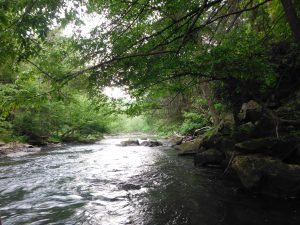Evaluating the Decline of Endangered Freshwater Mussels in the Clinch River (VA/TN)
 The Clinch River watershed of Virginia and Tennessee formerly supported one of the nation’s greatest concentrations of freshwater mussel biodiversity, but agricultural and mining practices, land development, contaminant spills, and other anthropogenic activities have degraded water and sediment quality in the Virginia section. Mussel populations in certain reaches have declined in both species richness and abundance, and there was a critical need to investigate the effects of potential landscape and chemical alterations to the system.
The Clinch River watershed of Virginia and Tennessee formerly supported one of the nation’s greatest concentrations of freshwater mussel biodiversity, but agricultural and mining practices, land development, contaminant spills, and other anthropogenic activities have degraded water and sediment quality in the Virginia section. Mussel populations in certain reaches have declined in both species richness and abundance, and there was a critical need to investigate the effects of potential landscape and chemical alterations to the system.
The overarching goal of this project was to evaluate the exposure and toxicological effects of contaminant stressors in the water and sediment of the Clinch River in areas of high mussel decline in Virginia and in areas of high abundance and recruitment in Virginia and Tennessee. To address our objectives, we (1) evaluated landscape changes; (2) conducted an in situ study of contaminants in resident and caged mussels; (3) examined contaminants in surface water, pore water, and bed and particulate sediments; and (4) conducted a laboratory experiment with field collected particulate sediment to assess toxicity of the river sediment load on young juvenile mussels. The laboratory study was published in Environmental Toxicology and Chemistry in 2016; pending additional publications, the full study is available in the Final Completion Report submitted to the US Fish and Wildlife Service.